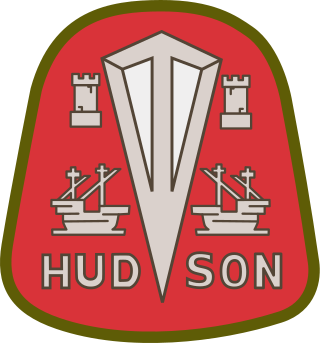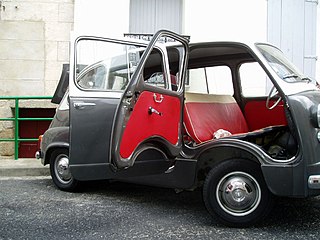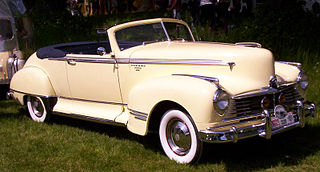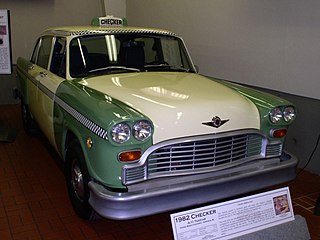Related Research Articles

The Hudson Motor Car Company made Hudson and other branded automobiles in Detroit, Michigan, U.S., from 1909 until 1954. In 1954, Hudson merged with Nash-Kelvinator to form American Motors Corporation (AMC). The Hudson name was continued through the 1957 model year, after which it was discontinued.

The AMC AMX is a two-seat GT-style muscle car produced by American Motors Corporation from 1968 through 1970. As one of just two American-built two-seaters, the AMX was in direct competition with the one-inch (2.5 cm) longer wheelbase Chevrolet Corvette, for substantially less money. It was based on the new-for-1968 Javelin, but with a shorter wheelbase and deletion of the rear seat. In addition, the AMX's rear quarter windows remained fixed, making it a coupe, while the Javelin was a true two-door hardtop.

The Ambassador is an automobile manufactured and marketed by American Motors Corporation (AMC) from 1957 through 1974 over eight generations, available in two- and four-door sedan, two-door hardtop, four-door station wagon as well as two-door convertible body styles. It was classified as a full-size car from 1957 through 1961, mid-size from 1962 until 1966, and again full-size from 1967 through 1974 model years.

The Nash Metropolitan is an American automobile assembled in England and marketed from 1953 until 1962.

Checker Motors Corporation was an vehicle manufacturer, and later an automotive subcontractor, based in Kalamazoo, Michigan. The company was established by Morris Markin in 1922, created by a merger of the firms Commonwealth Motors and Markin Automobile Body, and was initially named the Checker Cab Manufacturing Company. The manufacturer was originally based in Chicago, before moving to Kalamazoo in 1923. The company was renamed Checker Motors in 1958.

Power windows or electric windows are automobile windows which can be raised and lowered by pressing a button or switch, as opposed to using a crank handle.

The Indianapolis 500 auto race has used a pace car every year since 1911. The pace car is utilized for two primary purposes. At the start of the race, the pace car leads the assembled starting grid around the track for a predetermined number of unscored warm-up laps. Then if the officials deem appropriate, it releases the field at a purposeful speed to start the race. In addition, during yellow flag caution periods, the pace car enters the track and picks up the leader, bunching the field up at a reduced speed.

The Nissan Titan is a full-size pickup truck manufactured in the United States for the North American market by Nissan. It was named after the Titans of Greek mythology.

A bench seat is a full width continuous pad forming the front seat of automobiles. The second row of seating in most sedans is usually a bench. The third row of most SUVs and minivans, which may be forward-facing or rear-facing, is also a bench seat.

The Jeep Forward Control is a truck that was produced by Willys Motors, later named Kaiser Jeep, from 1956 to 1965. It was also assembled in other international markets. The layout featured a cab over design.

The Hudson Commodore is an automobile that was produced by the Hudson Motor Car Company of Detroit, Michigan between 1941 and 1952. During its time in production, the Commodore was the largest and most luxurious Hudson model.
The Nissan Pivo is a series of electric concept cars created by Nissan, with the first one introduced in 2005 at the Tokyo Motor Show.

The Volkswagen Amarok is a pickup truck produced by Volkswagen Commercial Vehicles since 2010. It is a body-on-frame truck with double-wishbone suspension at the front and leaf springs at the rear. The Amarok range consists of single cab and double cab, combined with either rear-wheel drive or 4motion four-wheel-drive, and is powered by turbocharged petrol or turbocharged direct injection (TDI) diesel engines.
Toyota Concept Vehicles produced between 1990 and 1999 include:
Toyota concept vehicles are transportation devices manufactured or designed by automobile company Toyota from 2000 to 2009. As their name suggests, these vehicles were concepts, and, as such, many were never released to dealerships. Many were developed in conjunction with other corporations such as Sony or Subaru.

The international or global version of the Ford Ranger is a series of pickup trucks sold by Ford under the Ranger nameplate mainly for markets outside the Americas since 1998. The 1998–2011 international Ranger models were jointly developed with Mazda, sharing the same assembly line and most parts with the Mazda B-Series and its successor, the Mazda BT-50. It is a successor of the Ford Courier as the Mazda-based Ford global pickup. The vehicles are mainly produced in the manufacturing plants in Rayong, Thailand and Pretoria, South Africa.
Toyota Concept Vehicles produced between 2010 and 2019 include:

Checker Taxi was a dominant taxicab company and national franchisor that was based in Chicago, Illinois. Checker Motors was an American vehicle manufacturer based in Kalamazoo, Michigan that built the iconic Checker Taxicab, sold commercially as the Checker Marathon until 1982. Both companies were owned by Morris Markin by the 1930s.

The Kia Telluride is a mid-size crossover SUV with three-row seating manufactured and marketed by Kia since 2019. Positioned above the smaller Sorento, the Telluride was previewed as a concept car in 2016, with the production model debuting in the spring of 2019 as a 2020 model. It shares components and specifications with its sister model, the Hyundai Palisade, including its engine, transmission, and wheelbase. Named after the town of Telluride, Colorado, the Telluride is the largest vehicle Kia has manufactured in the United States.

The Buick XP-300 is a concept car created by General Motors in 1951. It is a counterpart to GM's Le Sabre concept, with which it shares many mechanical components, including its supercharged V8 engine, which could run on either gasoline or methanol. The XP-300 is representative of GM's "long and low" design philosophy in the 1950s, and includes numerous innovative features ranging from push-button power windows and seats to hydraulic jacks and de Dion axles.
References
- ↑ Strohl, Daniel (June 7, 2022). "Lane Motor Museum acquires Sir Vival, the two-piece safety Hudson". hemmings.com. Hemmings . Retrieved 24 November 2022.
- ↑ Bennett, Rex (July 21, 2022). "The Survival Of 'Sir Vival,' The Strangest Safety Car Concept Ever, Now Rests in the Hands of the World's Quirkiest Car Museum". theautopian.com. Retrieved 24 November 2022.
- ↑ "Sir Vival- 1958". lanemotormuseum.org. Lane Motor Museum . Retrieved 24 November 2022.
- Mechanix Illustrated, April 1959. Cover Article "Amazing New Safety Car"
- Motor Trend, July 1959. The Sir Vival – a New “Safety” Car?
- Examiner.com 1958 Sir Vival: World's strangest car?